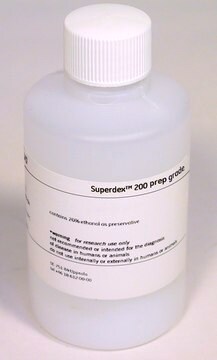GE28-9909-46
Superdex® 200 Increase 3.2/300
column L × I.D. 30 cm × 3.2 mm, 8.6 μm particle size
Synonym(s):
Superdex 200 Increase
About This Item
Recommended Products
material
glass column
titanium frit
product line
Superdex®
mol wt
10000-600000 Da (globular proteins)
packaging
1 ea of
parameter
<0.15 ml/min flow rate
3.0 Mpa (652 psi)
4-50 mL sample volume
bed volume
~2.4 mL
column L × I.D.
30 cm × 3.2 mm
matrix
agarose-dextran composite
polymeric
particle size
8.6 μm
cleaning
1-14
working range
3-12
separation technique
size exclusion (SEC)
General description
Superdex™ 200 Increase is a next-generation, dextran-agarose composite matrix for SEC. With smaller and more rigid beads than their predecessors, Superdex™ Increase columns deliver higher resolution purification in shorter run times.
Superdex™ 200 Increase has a selectivity curve optimized for excellent resolution of antibodies and macromolecules within the range Mr ~ 100 000 to ~ 300 000. It is well suited for detection and separation of antibody monomers, dimers, and aggregates present in monoclonal antibody preparations. The outstanding resolving power of this resin facilitates protein characterization, including analysis of antibody size variants, assessment of membrane protein size homogeneity, and the study of protein-protein interactions.
Superdex™ 200 Increase is optimized to give high resolution separation for proteins with molecular weights in the range Mr ~ 100 000 to ~ 300 000. Superose™ 6 Increase provides a complementary fractionation range, resolving very large protein complexes and macromolecules that Superdex 200 Increase cannot separate.
This agarose-based resin is alkali-resistant and supports cleaning-in-place (CIP) procedures. This capability allows the same column to be used for different proteins, with minimal risk of carry-over between samples.
Features and Benefits
- Enhanced performance: improved resolution and runtime compared to predecessor Superdex™ 200.
- Very high resolution: small bead size and narrow particle size distribution provide high resolution, for high protein purity.
- High flow rates: rigid beads give excellent pressure/flow properties.
Suitability
Storage and Stability
Legal Information
Signal Word
Warning
Hazard Statements
Precautionary Statements
Storage Class Code
3 - Flammable liquids
Certificates of Analysis (COA)
Search for Certificates of Analysis (COA) by entering the products Lot/Batch Number. Lot and Batch Numbers can be found on a product’s label following the words ‘Lot’ or ‘Batch’.
Already Own This Product?
Find documentation for the products that you have recently purchased in the Document Library.
Customers Also Viewed
Articles
Pressure is generated by the flow through the chromatographic system. For optimal chromatography functionality, it is important to understand the principle of the pressure drop over the different parts of a system.
Related Content
Superdex® from Cytiva are Size Exclusion Chromatography media consisting of a composite base matrix of dextran and agarose. This page shows how to perform a separation with a Superdex® column.
Our team of scientists has experience in all areas of research including Life Science, Material Science, Chemical Synthesis, Chromatography, Analytical and many others.
Contact Technical Service







